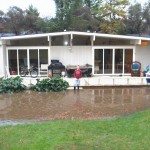
2005 New Years Eve Flood, backyard, only a couple more inches and then into the house. After this event I bought flood insurance.
Even though congress is wrangling over changes to the federally subsidized flood insurance program, no one is advocating that it be repealed like the Affordable Care Act. Since 1968, when the National Flood Insurance Program (NFIP) was created, it has been standard procedure to subsidize the flood insurance for a variety of buildings and contents. Yet, there are people who want to repeal the Affordable Care Act that will subsidize health insurance for American citizens.
Socialized flood insurance
NFIP is one of the few federally operated nationwide insurance programs along with crop insurance and Medicare. In all of these areas private insurance was either unwilling to enter the market or insurance rates for coverage was deemed to be excessively high to the participants. Consequently, the federal government stepped in to create nationwide programs that have some tax payer subsidies to the policy holders. In 2010 there were 5,646,735 NFIP policies in force.
How many vacation homes are being rebuilt under the NFIP?
The current impasse in congress over re-authorizing the NFIP is focused on the $18 billion debt caused by claims resulting from hurricanes Katrina and Rita in 2005. The most recent short-term reauthorization of the National Flood Insurance Program passed by the House will remove vacation and second homes from being eligible for coverage. But no one is talking about ending the subsidies all together. From NFIP Actuarial Review of 2010:
The average full-risk premium for these older buildings is currently estimated to be about five times greater than the average full-risk premium for compliant buildings. Even though these older, noncompliant buildings receive highly discounted premiums (estimated to be between 40% and 45% of the full-risk premium), subsidized premiums are still significantly higher than what actuarially rated policyholders pay for buildings constructed in compliance. This means that, if the Pre-FIRM subsidized portion of the business were charged full-risk premiums, affected policyholders would have to pay, on average, about two and a half times their current premium. To give a sense of the impact eliminating the subsidy would have on the program as whole, increasing the premium for subsidized policyholders while leaving the remaining policyholders unchanged would cause the aggregate premium for the entire NFIP to increase on the order of 50% to 75%.
Why didn’t anyone tell me?
After a flooding event at my house in 2005 I purchased a NFIP policy. For 2011, my yearly premium was $343 for $200,000 on the house and $80,000 for the contents with a $1,000 deductible for each. I am not mandated to purchase it and my area is not in a recognized flood zone. A seasonal creek that runs through the back yard, poor subdivision drainage, and the neighbors telling me the house had flooded before, prompted me to purchase flood insurance.
I am uncertain if my policy premium is being subsidized or not. My regular home and property insurance only runs about $700 per year. There is a pretty good certainty that my property will flood again and it may enter the house like it did sometime in the 1980’s. When that event happens, I will be fortunate to have my NFIP policy.
If a federal subsidy is good enough for a barn…
My neighbors and their children should be viewed as just as valuable as my house and contents by the federal government. If we can create and maintain a national program to subsidize flood insurance for vacation homes, second homes and barns, we can certainly subsidize the health insurance for one of America’s greatest assets, our citizens.



